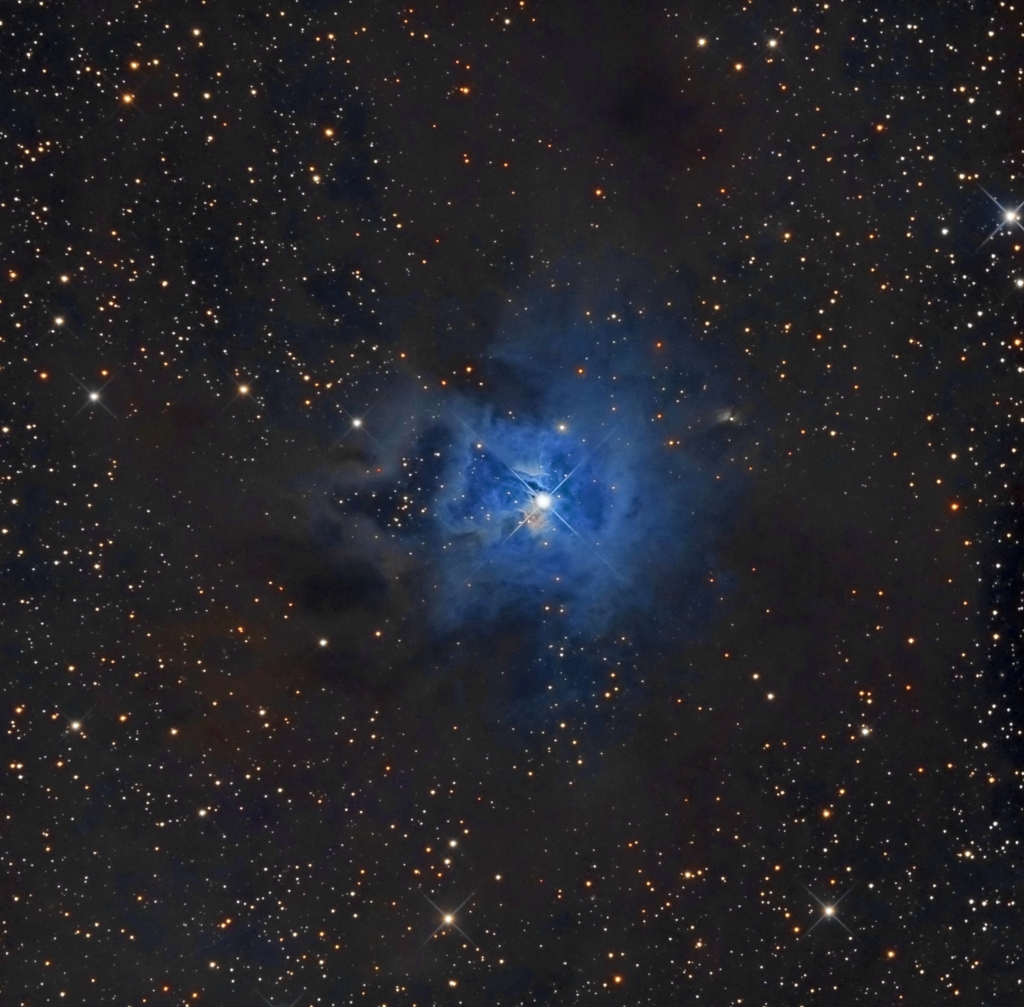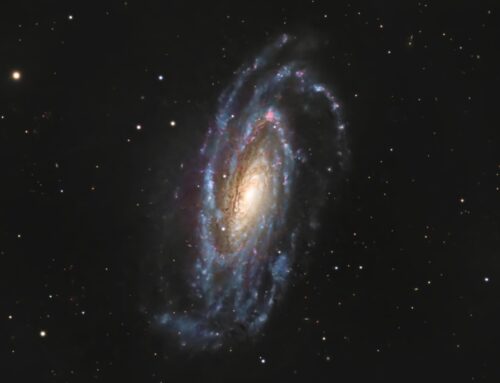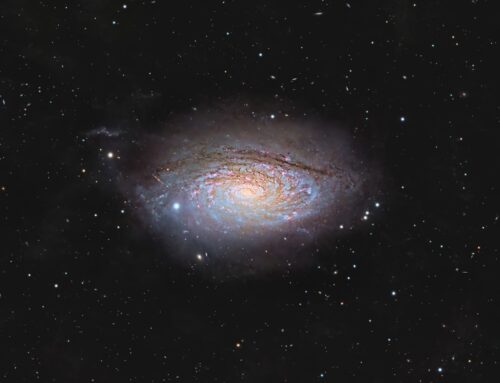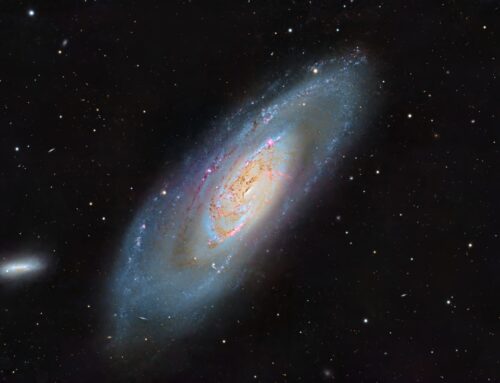NGC7023, The Iris Nebula
Click image for full size version
August 30, 2013, Astronomy Magazine Online Picture of the Day, April 1, 2016
 This is the Iris Nebula, and I think it’s one of the nicest shots I’ve ever taken. I used two telescopes and two cameras: one pair for the colour data, and a different combination for the luminance (brightness). It’s significant for another reason: this is the last image that I will get with my trusty MI-250 mount, which is up for sale. It’s replacement is expected to arrive soon (If you are an astronomer and are interested, the add is at astromart.com, ad number 830235). The Iris nebula is a reflection nebula, the blue coming from light reflected off soot/dust behind the bright star. There is lots of soot and dust visible throughout the image. This nebula is in our own Milky Way galaxy, and is relatively close at about 1300 light years. The star at the centre of the nebula is easy in binoculars, but the nebula itself is very challenging to see visually. The brightness images actually cover a much wider field than shown here. This is just the area of sky for which I had both colour and brightness data. I plan to shoot new colour data, and more brightness, once the new mount arrives, so expect to see this again soon, but in a “bigger frame.”
This is the Iris Nebula, and I think it’s one of the nicest shots I’ve ever taken. I used two telescopes and two cameras: one pair for the colour data, and a different combination for the luminance (brightness). It’s significant for another reason: this is the last image that I will get with my trusty MI-250 mount, which is up for sale. It’s replacement is expected to arrive soon (If you are an astronomer and are interested, the add is at astromart.com, ad number 830235). The Iris nebula is a reflection nebula, the blue coming from light reflected off soot/dust behind the bright star. There is lots of soot and dust visible throughout the image. This nebula is in our own Milky Way galaxy, and is relatively close at about 1300 light years. The star at the centre of the nebula is easy in binoculars, but the nebula itself is very challenging to see visually. The brightness images actually cover a much wider field than shown here. This is just the area of sky for which I had both colour and brightness data. I plan to shoot new colour data, and more brightness, once the new mount arrives, so expect to see this again soon, but in a “bigger frame.”
Tekkies:
COLOUR (SUMMER 2011): 40x15s, 12x1m, 12x5m, 6x10m, 16x15m, light frames with good transparency, fair seeing and no moon. Acquired using Nebulosity 2 software, QHY8 camera (Gain=0; Offset=125) with UV/IR filter and a 152 mm refractor at f/8 on an MI-250 mount. The mount was autoguided using PHD software, and the KWiqGuide system from KW Telescope. Light frames were calibrated with 9 darks (bad pixel mapping only), 50 flats and 50 bias frames. The calibration was done in Images Plus 3.0. Alignment, stacking and processing exclusively using PixInsight. HDR Combine Tool used as follows: After calibrating and aligning all the light frames, I made master 15s, 1m, 5m, 10m and 15m frames. I did background extraction and colour calibration on these images, and then used the HDRCombine Tool in PixInsight to make a single 64-bit HDR frame. This frame was then processed using my normal work flow in PixInsight. Final image was saved as a jpg at full scale, about 1.25 arcsec/pixel. Shot from my SkyShed just north of Guelph, ON.
LUMINANCE (SUMMER 2013): 20x10mL unbinned (total=3hr20m). SBIG STL-11000M camera, Baader LRGB filters, 10″ f/6.8 ASA astrograph, MI-250 mount. Guided with STL-11000’s external guider. No moon. Average transparency and good seeing. The luminance image was processed in PixInsight as follows: DBE, Deconvolution, ATrous Wavelets, Histogram Stretch, HDR Multiscale Transform (6 and 4 layers), . The image scale for the luminance data is about 1.1 arcsec/pixel.
COMBINING LUMINANCE AND RGB: After realigning and cropping, Luminance was added to the RGB using the LRGBCombine tool in PixInsight with Chrominance Noise Reduction on. Local HistogramEqualization was applied to the nebula, and exponential transformation was applied to the background areas. Unsharp mask was applied to the brightest portions of the nebula. Curve tool was used to increase contrast and brightness, followed by decreasing colour saturation in background and around brightest stars.
Final image scale is 1.1 arc sec/pixel (the scale of the 2013 luminance data).







Very nice Ron! I like the blue colour, the contrast, and the detail. Nice job. …Les